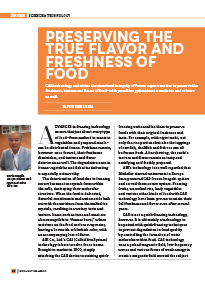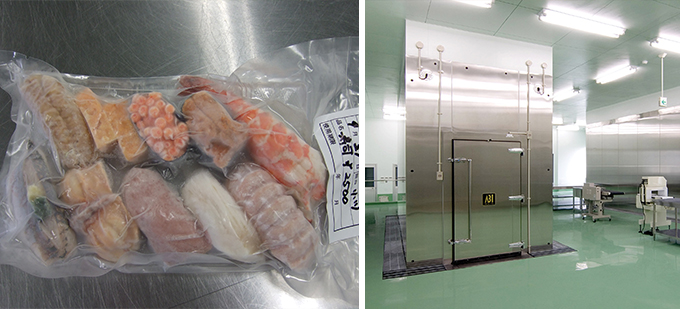Home > Highlighting JAPAN >Highlighting Japan July 2015>Science & Technology
Highlighting JAPAN

Science & Technology
Preserving the True Flavor and Freshness of Food
CAS technology maintains the structural integrity of frozen organic matter to preserve the freshness, texture and flavor of food—with possible applications in medicine and science as well.

Advances in freezing technology ensure that just about every type of food—from seafood to meats to vegetables and prepared meals—can be distributed frozen. Problems remain, however: once thawed, their freshness diminishes, and texture and flavor deteriorate as well. The degradation seen in frozen vegetables and fish after defrosting is especially noteworthy.
The deterioration of food due to freezing occurs because ice crystals form within the cells, destroying their molecular structure. When the food is defrosted, flavorful constituents and amino acids leak out with the moisture from the melted ice crystals, resulting in a watery taste and texture. Items such as tuna and meat are also susceptible to “freezer burn,” where moisture on the food surface evaporates, leaving a brownish or blackish color, with an accompanying loss of flavor.
ABI Co., Ltd.’s CAS (Cells Alive System) technology is here to solve those issues. Brought to market in 2000, simply attaching the CAS device to existing quick-freezing units enables them to preserve foods with their original freshness and taste. For example, with nigiri sushi, not only the rice portions but also the toppings of raw fish, shellfish and fish roe can all be frozen fresh. After thawing, the sushi’s texture and flavor remain as tasty and satisfying as if freshly prepared.
ABI’s technology is so well regarded that Michelin-starred restaurants in Europe have procured CAS-frozen Iwagaki oysters and served them as raw oysters. Freezing fruits, uncooked rice, leafy vegetables and various other kinds of food with CAS technology have been proven to retain their full freshness and flavor even after several years.
CAS is not a quick-freezing technology, however. It is ultimately a technology to be paired with quick-freezing techniques to prevent degradation in food quality by controlling the formation of water molecules within food. CAS technology uses a pulsed magnetic field, low-frequency waves and various forms of weak energy to create a magnetic field around the subject material. A CAS field-generating device installed in a freezer unit causes the interstitial water molecules within food to vibrate, refining the ice crystals that form within the cells. This prevents the ice crystals from destroying the cell walls and membranes within food. Because the cellular tissue is undamaged, the flavors, aromas and textures remain intact.
“One big advantage of CAS technology is that you can install it on existing freezer units, allowing for remarkably high levels of freshness in frozen foods without incurring high costs,” explains ABI president and representative director Norio Owada. “Because of this, we’ve received high praise from overseas, and food-processing manufacturers all over the world are now using CAS technology.” Since this freezing process doesn’t degrade freshness, overseas food products can be imported inexpensively, and also allows more Japanese food products to be shipped globally.
“As Japan’s population continues to age, and worries mount about a future drop in production capacities, CAS technology will become important for primary industries such as agriculture and fishing,” Owada says. Producing and selling only raw ingredients isn’t enough to win against large-scale foreign makers. By spreading processed and frozen “Japanese flavor” offering the same quality as fresh to the rest of the world, Owada hopes to firmly establish the industry and create a path for future generations.
He also wants to appeal to food producers across the nation. “This is not just about expensive washoku (traditional Japanese cuisine), but ultimately familiar Japanese foods that everyone can have an affinity with,” he explains. “With this technology, Japanese regional food and home cooking can become everyday foods all over the world.”
CAS technology has drawn attention from the fields of science and medicine as well. In the area of regenerative medicine utilizing induced pluripotent stem cells (iPS) and liver cells, CAS has already been applied to the cryopreservation of cells and internal organs, and technological development and research will begin on the cryopreservation of blood, which has been considered difficult to store over long periods of time. Originally started as a method to freeze foods, ambitious efforts are now under way to use CAS technology to drive new developments in Japanese industry and medical care.
© 2009 Cabinet Office, Government of Japan






